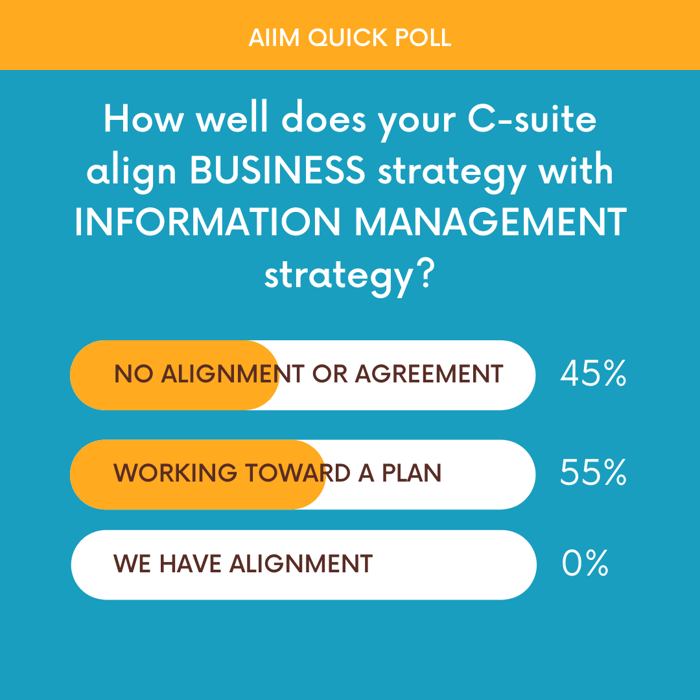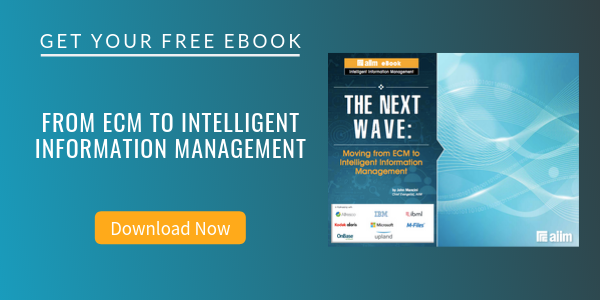
How Well Does Your Information Strategy Align with Your Business Goals?
Intelligent Information Management (IIM) | Digital Transformation
In both our personal and professional lives, the amount of information we deal with on a daily basis is growing exponentially. At the same time, the variety of this information is evolving -- audio files, video files, and more. The cummulative effect? Information Chaos!
For many organizations, information is largely viewed as an achilles heel that must be tamed and controlled. Efforts to do so have largely been focused on reducing cost and risk. However, if information is the currency that fuels digital transformation, organizations cannot continue down the path of viewing information management decisions solely through a tactical cost-minimization filter. In a digital age, the everyday decisions that organizations make about information must become strategic business decisions and must also consider information as a strategic enabler.
 The Case for Alignment
The Case for Alignment
The AIIM Certified Information Professional (CIP) Study Guide clearly lays out the case for the importance of business/information management alignment:
"Most organizations and departments have a mandate to continuously improve operations. A conventional change agenda involves better tools and technology, better behaviors, and better processes, all focused on generating better efficiencies and improved productivity.
Ultimately, AIIM believes digital transformation is more than conventional change. Digital transformation is about doing things differently – and doing different things. And different not just for the sake of being different, but in support of the key strategic objectives facing every organization in the age of digital disruption. In other words, digital transformation is not about incremental process improvement. Digital transformation is about using information in brand new ways.
The focus for information management is broader than simply reducing information-based costs and risks. While this is important, it is insufficient. Rather, organizations need to focus on how to effectively monetize their information assets, directly or indirectly, to move the organization forward. Information management must become a business enabler."
The Harvard Business Review (“Is Your IT Department Aligned With Your Business Outcomes?”) reinforces how critical it is, especially now, for organizations to place renewed emphasis on more effectively aligning their business and technology strategies:
"Over the years, many organizations have weathered moments of upheaval. But this pandemic presents challenges unprecedented in their pace and scale. No doubt, challenges will continue to emerge and quickly evolve. To respond with the speed and agility required, business leaders must effectively leverage digital technology and establish quick and reliable methods for identifying needs, adjusting plans, and measuring results. With technology and business goals so inextricably interwoven, there is heightened urgency today around getting digital transformation right… Ultimately, there’s a fundamental and costly lack of alignment and a persistent gap between IT and business. And this organizational disconnect has become the biggest impediment to digital transformation."
Information Professionals Weigh-In
What’s this like in real organizations? Let’s take a look.
In February 2021 as a part of AIIM’s State of the Intelligent Information Management (IIM) study, respondents were asked to grade their organizations on their business and information alignment.
Overall, the AIIM Community responded with a C-minus.
This is clearly a wake-up call for us all to get serious about improving how we link business and information management strategies. Almost half of participants (46%) grade their efforts at alignment either as “needs improvement” or “poor.”
Here are some of the comments from survey participants that stood out:
- "We have no leadership alignment and agreement on objectives and solutions and strategy."
- "There still exists a divide between IT and business lines – neither wants to serve as a water-carrier for the other. Additionally, IT is continually positioning itself as an essential function rather than a service to the mission of the organization; a position that both confuses and conflates focus and resources."
- "Information Management is not part of strategy... it’s mostly an afterthought."
- "We try to align the two strategies, but it is difficult when you are catching up information management-wise and trying to innovate for the business. So, you end up with partially aligned strategies."
- "We know what has to be done but getting there and aligning the various strategies is difficult."
- "We try to align information management strategy with business strategy, but not the other way around. This is often wasteful and shortsighted."
- "The integration of information management into our business strategy is very high. We use it to define, control, and support our business strategy. But we are still not managing our information assets perfectly."
- "Dealing with COVID has forced us to adjust to the new way of dealing with information management. We have done more electronically due to the facilities being closed to the public. Ensuring that the proper equipment was in place as we worked remotely was a challenge."
Almost 6 months after this initial research study, we revisited the conversation with a quick poll on LinkedIn and AIIM’s Online forum. Here’s a look at the results:
Although no respondents reported that they have a plan in place at this time, it’s exciting to see over 50% working toward a plan. An initiative like this is not an overnight change. We should hopefully see these numbers improve as time goes on.
Six Ways to Improve Your Business/Information Strategy Alignment
- Embrace Flexibility in the Wake of COVID: In every organization, for every person who loves working at home, there is somebody else who cannot get out of the house quickly enough. And for every person who is super social, there’s another one who is an introvert and would love to be working from home. COVID has forced people to figure out remote working. Hopefully now that’s done, and you’ve made a big investment in sorting out the issues and making sure the infrastructure is there. You may have put the infrastructure in place while in panic mode, but now you need to optimize it. Why wouldn’t you make the most of it? The key for most organizations post-COVID is going to be flexibility.
- Elevate the Conversation about Information Value: It’s all about driving value for the organization. Years ago, I was trying to roll out records management across the organization. The hardest lesson I learned was that nobody recognized the value of records unless they understood the value of that information. That meant transitioning from viewing a record as something you just stored, archived, and retained to something of value that you could utilize to extend your work processes.
- Create an Internal Framework to Understand and Balance both Risk AND Value: You have information everywhere and you need to start somewhere. Start by assigning both risk and value metrics to each source of information and begin by attacking information sources that are high-risk and high-value.
- Clearly Affix Senior Responsibility: If you want digital transformation, someone has to lead it. They must be empowered to drive change and supported by the C-Suite and Board. Transformation does not just “happen” – it must be driven and actively pushed. In some organizations, transformation will be embraced and supported, in others it will be met with a resounding “meh,” and in others it will be actively resisted. An empowered and supported leader is required in all these cases. The leader must be able to shine a light on the truth of the situation in order to gain broad consensus on what needs to be done.
- Push the Business to Lead Alignment: It always comes back to what we’re selling or what we’re making or how we use business processes to get work done, which means that the business needs to lead alignment efforts. They may need some coaching and some help with the information management side of things. But I actually think it’s easier to coach and assist and guide a business leader to understand the information management perspective than it is to take an IT person and try to have them lead a business function. We don’t do information management for the sake of information management; information management is a support function. That doesn’t reduce its importance.
- Identify Cultural Pressure Points that can be Leveraged: Our company prides itself on being the most client-centric company in our space. Content and information are at the heart of delivering upon this strategic priority. We used this cultural norm of customer-centricity to get senior executives to buy into a strategy of centrally managing information instead of having multiple hubs of information.
More on Information and Business Strategy Alignment
For more on this topic, download a free copy of AIIM's 2021 State of the Intelligent Information Management Industry report. In the report, we discuss the state of information management within organizations, based on research conducted with 229 decision-makers drawn from the AIIM community.
Learn more about information and business strategy alignment and the other key trends in information management, including:
- The C-Suite is failing to align business and technology strategies.
- Organizations are losing the battle against information chaos and need to rethink outdated manual approaches to information management.
- Organizations need to increase their investment in critical IIM competencies.
- Money, focus, and culture – not just technology – are key to true digital transformation




